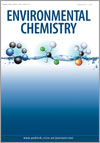Environmental Chemistry
Volume 8
Number 4 2011
RESEARCH FRONT: Polyfluorinated Compounds
Perfluoroalkyl substances were recognised as global environmental pollutants 10 years ago. Although considerable advancements have been made in our understanding of the environmental distribution, fate and toxicity of perfluoroalkyl substances, several important issues remain to be resolved. This article identifies existing knowledge gaps that deserve further investigations to enable meaningful regulatory decisions.
Five years ago a well-cited review of the sources and fate of perfluorinated carboxylates was published. The findings of that review are revisited here in light of recently published measurement and modelling studies of the sources and fate of these compounds, and an attempt is made to reconcile the many seemingly disparate findings reported. This review also aims to provide a road map for future research on the sources and fate of perfluorinated carboxylates and related compounds.
As perfluorocarboxylates can be carried by surface runoff to waters and cause adverse effects to aquatic organisms, we evaluated the contributions of wastewater and surface runoff to the concentrations of these compounds in Tokyo Bay during dry and wet weather. Sewage markers revealed that the surface runoff was a significant source of perfluorocarboxylates in the bay during wet weather. This finding leads to a greater understanding of sources and pathways of perfluorocarboxylates in waters.
Polyfluoroalkyl compounds, widely used chemicals in consumer and industrial products, are global pollutants in the environment. Transport mechanisms and environmental pathways of these compounds, however, are not yet fully understood. We show that a wastewater treatment plant can be an important source for polyfluoroalkyl compounds to the atmosphere where they have the potential to be transported long distances.
Perfluoroalkyl acids are used in many products and have spread into the environment where their persistence and potential toxicity pose a threat to humans and wildlife. The present study describes environmental contamination from usage of aqueous film forming foams, and investigates the distribution of structural isomers of perfluoroalkyl acids from a point source to the surrounding environment. Isomer patterns might be used to track contamination sources since isomer composition differs in the various products containing perfluoroalkyl acids. The environmental behaviour of these structural isomers is described, and limitations of their use to track contamination sources are identified.
Perfluorinated alkyl acids are found in the remotest parts of the world, but it is still not known how they get there. By using a laboratory sea spray simulator, it is shown that these compounds are efficiently transferred from water to air. This indicates that perfluorinated alkyl acids could be transported long distances as a result of breaking waves ejecting them into the atmosphere.
Poly- and perfluorinated alkyl substances (PFASs) include a wide range of individual compounds that are used in many consumer products, but only a few physicochemical property data are available for these chemicals. Here we provide estimates of physicochemical properties (vapour pressure, water solubility, etc.) of 130 individual PFASs derived with a quantum-chemical model. Our results provide insight into the effect of molecular structure on the properties of PFASs and a basis for estimating the environmental partitioning and fate of PFASs.
Perfluoroalkyl compounds are of rising environmental concern because of their ubiquitous distribution in remote regions like the Arctic. The present study quantifies these contaminants in the gas and particle phases of the Canadian Arctic atmosphere. The results demonstrate the important role played by gas–particle partitioning in the transport and fate of perfluoroalkyl compounds in the atmosphere.
A total of 21 perfluorinated compounds (PFCs) including PFOS were quantified in river waters, sewage, sea waters, shallow ground waters as well as fish and domestic poultry, focussed on the main river basins in Shenyang and the Yangtze River Delta areas, China. The distribution characteristics of PFCs in the aquatic environment and evaluation of the potential risk for human health via the diet of fish was discussed. Comprehensive research was carried out using the world leading knowledge about PFOS-related chemicals in AIST, Japan to enable reliable evaluation of PFOS risk in Chinese environments, supported by ISO25101.
Perfluorinated compounds are commonly used chemicals that are detected globally in all environmental matrices. We investigated the extent of contamination by perfluorinated compounds in the red-throated diver, a marine predatory bird, and observed an unusual distribution of perfluorinated compounds in tissues. The data help us to better understand the behaviour of these contaminants in organisms.
Volatile organic compounds can adsorb to the surfaces of silicates present in atmospheric aerosols, but the mechanisms and interactions are not well understood. We compare theoretical approaches for describing the adsorption of polyaromatic heterocycles to a model phyllosilicate surface. The enthalpy and spectroscopic data for this adsorption provide valuable information for future experimental studies on these atmospheric pollutants.
Low-molecular weight aldehydes and ketones formed in the oceans may be transferred to the atmosphere, affecting its oxidant chemistry and capacity. This in turn affects the lifetimes of other trace gases, as well as leading to secondary organic aerosol formation, both of which have climatic implications. We describe a facile, economical and readily available technique to measure low-molecular weight aldehydes and ketones in seawater.
The absorption of water by mixtures of organic matter in aerosols influences various atmospheric processes, such as scattering of solar radiation and cloud formation. We use X-ray techniques to elucidate the swelling behaviour of representative organic matter under humid, sub-saturated conditions, and show chemical separation according to the functional group composition in the organic mixtures upon water uptake. The results will further our understanding of the complex role of aerosol organic matter in atmospheric processes.




